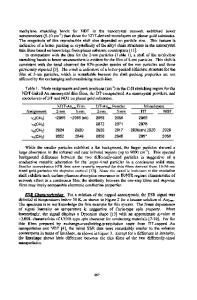Nanocomposite Films derived from Alkoxysilane Terminated Amide Acid Oligomers and Carbon Nanotubes
- PDF / 157,508 Bytes
- 5 Pages / 612 x 792 pts (letter) Page_size
- 49 Downloads / 255 Views
Nanocomposite Films derived from Alkoxysilane Terminated Amide Acid Oligomers and Carbon Nanotubes Joseph G. Smith Jr., John W. Connell, Peter Lillehei, Kent A. Watson*, and Craig M. Thompson** National Aeronautics and Space Administration, Langley Research Center Hampton, VA 23681-2199 *ICASE **National Resarch Council Research Associate ABSTRACT Low color, space environmentally stable, polymeric materials with sufficient electrical conductivity for static charge dissipation are of interest for potential applications on Gossamer spacecraft. One method of imparting electrical conductivity while maintaining optical clarity is through the use of single wall carbon nanotubes (SWNTs). Both theory and research on SWNTs have shown them to be conductive. However, SWNTs are very difficult to uniformly disperse in a polymer. The approach described herein was to use oligomers endcapped with functional groups that could condense with functionalities present on purified, laser ablated SWNTs. Low color, radiation resistant amide acid oligomers endcapped with trialkoxysilane groups were combined with SWNTs. Since the SWNTs were purified by an oxidative process (nitric/sulfuric acid treatment), they have functionalities such as hydroxyl and carboxylic acid groups that can condense with the terminal alkoxysilane groups. After mixing at room temperature, the mixtures were used to cast films that were subsequently stage-cured up to 300°C for 1 hour in air. During this thermal treatment, imidization and condensation occurred. The chemistry, physical, and mechanical properties of the resulting nancomposite films will be presented. INTRODUCTION NASA has interest in developing large, deployable, ultra lightweight spacecraft to meet future mission needs. These Gossamer spacecraft are envisioned to be compliant enough to be folded into compact volumes (suitable for conventional launch vehicles) prior to launch and upon achieving orbit automatically deploy into structures that are many square meters in dimension[1]. For these spacecraft to be realized, materials with specific combinations of physical, mechanical, optical and electrical properties are needed. Much progress has been made with regard to developing materials with the needed combination of properties. However, attaining sufficient electrical conductivity without degrading other important properties has been elusive. Since the discovery of carbon nanotubes (CNTs) in 1991, research has been ongoing to take advantage of the exceptional mechanical and electrical properties exhibited by CNTs. Both multiwalled (MWNT) and single walled (SWNT) nanotubes have been prepared by processes such as arc discharge, laser ablation (LA), chemical vapor deposition, or high pressure carbon monoxide (HiPCO) with the greatest property enhancements anticipated from SWNTs [2,3]. To take full advantage of CNT properties, they need to be uniformly dispersed throughout the organic matrix in the preparation of nanocomposites. The incorporation and dispersion of CNTs into polymeric matrices has been difficu
Data Loading...











